A) 1.
B) 2.
C) 3.
D) 4.
E) 5.
Correct Answer

verified
Correct Answer
verified
Multiple Choice
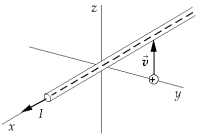 The current in a wire along the x-axis flows in the positive x direction. If a proton, located as shown in the figure, has an initial velocity in the positive z direction, it experiences
The current in a wire along the x-axis flows in the positive x direction. If a proton, located as shown in the figure, has an initial velocity in the positive z direction, it experiences
A) a force in the direction of positive x.
B) a force in the direction of negative x.
C) a force in the direction of positive z.
D) a force in the direction of positive y.
E) no force.
Correct Answer

verified
Correct Answer
verified
Multiple Choice
A beam of charged particles moving with a speed of 106 m/s enters a uniform magnetic field of 0.1 T at right angles to the direction of motion. If the particles move in a radius of 0.2 m, then calculate their period of motion.
A) 6.3 × 10-7 s
B) 1.3 × 10-7 s
C) 1.3 × 10-6 s
D) 4.1 × 10-7 s
E) None of the above.
Correct Answer

verified
Correct Answer
verified
Multiple Choice
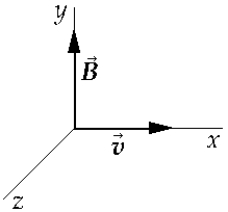 A neutron moving along the +x-axis with velocity v enters a region where there is a uniform magnetic field B along the +y-axis. As the neutron moves through this region, it is
A neutron moving along the +x-axis with velocity v enters a region where there is a uniform magnetic field B along the +y-axis. As the neutron moves through this region, it is
A) deflected in the positive y direction.
B) deflected in the positive z direction.
C) deflected in the negative y direction.
D) deflected in the negative z direction.
E) undeviated in its motion.
Correct Answer

verified
Correct Answer
verified
Multiple Choice
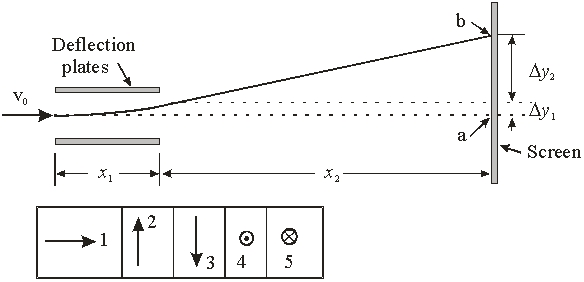 Electrons traveling at a speed of v0 = 3 × 107 m/s pass through the deflection plates. The electric field between the plates is E = 5000 V/m and spans a distance of x1 = 5 cm. The electrons then travel a further distance of x2 = 40 cm along the x-axis. With the magnetic field turned off, what is the deflection y1 as the electron exits the region between the plates?
Electrons traveling at a speed of v0 = 3 × 107 m/s pass through the deflection plates. The electric field between the plates is E = 5000 V/m and spans a distance of x1 = 5 cm. The electrons then travel a further distance of x2 = 40 cm along the x-axis. With the magnetic field turned off, what is the deflection y1 as the electron exits the region between the plates?
A) 1.22 × 10-3 m
B) 1.95 × 10-2 m
C) 2.07 × 10-2 m
D) 9.50 × 10-3 m
E) 1.38 × 10-2 m
Correct Answer

verified
Correct Answer
verified
Multiple Choice
A charged particle is moving horizontally westward with a velocity of 3.5 × 106 m/s in a region where there is a magnetic field of magnitude 5.6 × 10-5 T directed vertically downward. The particle experiences a force of 7.8 × 10-16 N northward. What is the charge on the particle?
A) +4.0 × 10-18 C
B) -4.0 × 10-18 C
C) +4.9 × 10-5 C
D) -1.2 × 10-14 C
E) +1.4 × 10-11 C
Correct Answer

verified
Correct Answer
verified
Multiple Choice
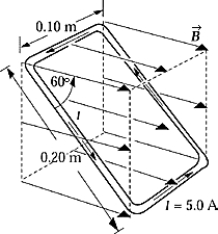 A rectangular loop of wire 0.10 m by 0.20 m) carries a current of 5.0 A in a counterclockwise direction. The loop is oriented as shown in a uniform magnetic field of 1.5 T. The magnitude of the torque acting on the loop is
A rectangular loop of wire 0.10 m by 0.20 m) carries a current of 5.0 A in a counterclockwise direction. The loop is oriented as shown in a uniform magnetic field of 1.5 T. The magnitude of the torque acting on the loop is
A) 15 x 10-2 N . m.
B) 75 x 10-2 N . m.
C) 50 x 10-2 N . m.
D) 13 x 10-2 N.
E) 7.5 x 10-2 N . m.
Correct Answer

verified
Correct Answer
verified
Multiple Choice
A small positively charged body is moving horizontally and westward. If it enters a uniform horizontal magnetic field that is directed from north to south, the body is deflected
A) upward.
B) downward.
C) toward the north.
D) toward the south.
E) not at all.
Correct Answer

verified
Correct Answer
verified
Multiple Choice
Two long, straight parallel wires 7.6 cm apart carry currents of equal magnitude I. They attract each other with a force per unit length of 4.3 nN/m. The current I is approximately
A) 1.6 mA.
B) 40 mA.
C) 37 mA.
D) 59 mA.
E) 4.0 mA.
Correct Answer

verified
Correct Answer
verified
Multiple Choice
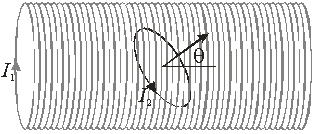 A coil of radius R = 5 cm lies inside a long solenoid that carries a current I1 = 10 A and has 800 turns per meter. The coil carries a current I2 = 4 A and the normal of the plane of the coil is at an angle = 30º with the axis of the solenoid. The magnitude of the torque on the coil is
A coil of radius R = 5 cm lies inside a long solenoid that carries a current I1 = 10 A and has 800 turns per meter. The coil carries a current I2 = 4 A and the normal of the plane of the coil is at an angle = 30º with the axis of the solenoid. The magnitude of the torque on the coil is
A) 1.57 × 10-4 N m.
B) 2.74 × 10-4 N m.
C) 5.03 × 10-5 N m.
D) 3.16 × 10-4 N m.
E) None of the above.
Correct Answer

verified
Correct Answer
verified
Multiple Choice
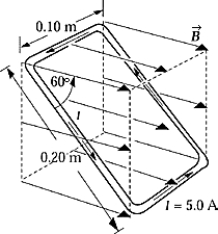 A rectangular loop of wire 0.10 m by 0.20 m) carries a current of 5.0 A in a counterclockwise direction. The loop is oriented as shown in a uniform magnetic field of 1.5 T. The force acting on the upper 0.10-m side of the loop is
A rectangular loop of wire 0.10 m by 0.20 m) carries a current of 5.0 A in a counterclockwise direction. The loop is oriented as shown in a uniform magnetic field of 1.5 T. The force acting on the upper 0.10-m side of the loop is
A) 1.5 N.
B) 0.75 N.
C) 0.50 N.
D) 0.15 N.
E) zero.
Correct Answer

verified
Correct Answer
verified
Multiple Choice
An electron is traveling horizontally east in the magnetic field of Earth near the equator. The direction of the force on the electron is
A) zero.
B) north.
C) south.
D) upward.
E) downward.
Correct Answer

verified
Correct Answer
verified
Multiple Choice
What is the magnetic field at the center of a circular loop with a diameter of 15.0 cm that carries a current of 1.50 A?
A) zero
B) 6.28 × 10-6 T
C) 1.26 × 10-5 T
D) 2.51 × 10-5 T
E) 1.68 × 10-4 T
Correct Answer

verified
Correct Answer
verified
Multiple Choice
A 30 cm long wire with an east-west orientation carries a current of 3.0 A westward. There is a uniform magnetic field perpendicular to this wire. If the force on the wire is 0.18 N upward, what are the direction and magnitude of the magnetic field?
A) 0.20 T up
B) 0.20 T north
C) 0.20 T south
D) 2.0 × 10-3 T north
E) 2.0 × 10-3 T up
Correct Answer

verified
Correct Answer
verified
Multiple Choice
A long solenoid of radius 3 cm has 1100 turns per meter. If the solenoid carries a current of 1.5 A, then calculate the magnetic field at the center of the solenoid.
A) 2.1 × 10-3 T
B) 1.0 × 10-3 T
C) 1.7 × 10-4 T
D) 7.0 × 10-2 T
E) None of the above.
Correct Answer

verified
Correct Answer
verified
Multiple Choice
If the magnetic field vector is directed toward the north and a negatively charged particle is moving toward the west, what is the direction of the magnetic force on the particle?
A) up
B) west
C) south
D) down
E) east
Correct Answer

verified
Correct Answer
verified
Multiple Choice
 Two long parallel wires are a distance d apart and carry equal and opposite currents. Point P is at a distance d from each of the wires. Which diagram best represents the direction of the magnetic field at point P?
Two long parallel wires are a distance d apart and carry equal and opposite currents. Point P is at a distance d from each of the wires. Which diagram best represents the direction of the magnetic field at point P?
A) 1
B) 2
C) 3
D) 4
E) 5
Correct Answer

verified
Correct Answer
verified
Multiple Choice
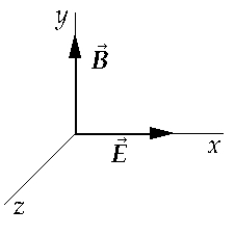 A negatively charged particle is moving through uniform fields E and B, which are directed in the positive x and positive y directions, respectively. If there is no resultant force on the particle, then its velocity is in the
A negatively charged particle is moving through uniform fields E and B, which are directed in the positive x and positive y directions, respectively. If there is no resultant force on the particle, then its velocity is in the
A) positive x direction.
B) positive y direction.
C) negative x direction.
D) positive z direction.
E) negative z direction.
Correct Answer

verified
Correct Answer
verified
Multiple Choice
A beam of electrons q = 1.6 × 10-19 C) is moving through a region of space in which there is an electric field of intensity 3.4 × 104 V/m and a magnetic field of 2.0 × 10-3 T. The electric and magnetic fields are so oriented that the beam of electrons is not deflected. The velocity of the electrons is approximately
A) 6.8 × 106 m/s.
B) 3.0 × 108 m/s.
C) 6.0 × 10-9 m/s.
D) 0.68 km/s.
E) 1.7 × 107 m/s.
Correct Answer

verified
Correct Answer
verified
Multiple Choice
An alpha particle of charge +2e and mass 41.66 × 10-27) kg, and an 16O nucleus of charge +8e and mass 161.66 × 10-27) kg have been accelerated from rest through the same electric potential. They are then injected into a uniform magnetic field B, where both move at right angles to the field. The ratio of the radius of the path of the alpha particle to the radius of the path of the nucleus 16O is
A) r /rO = 1/1.
B) r /rO = 1/4.
C) r /rO = 1/8.
D) r /rO = 1/2.
E) None of these is correct.
Correct Answer

verified
Correct Answer
verified
Showing 81 - 100 of 105
Related Exams